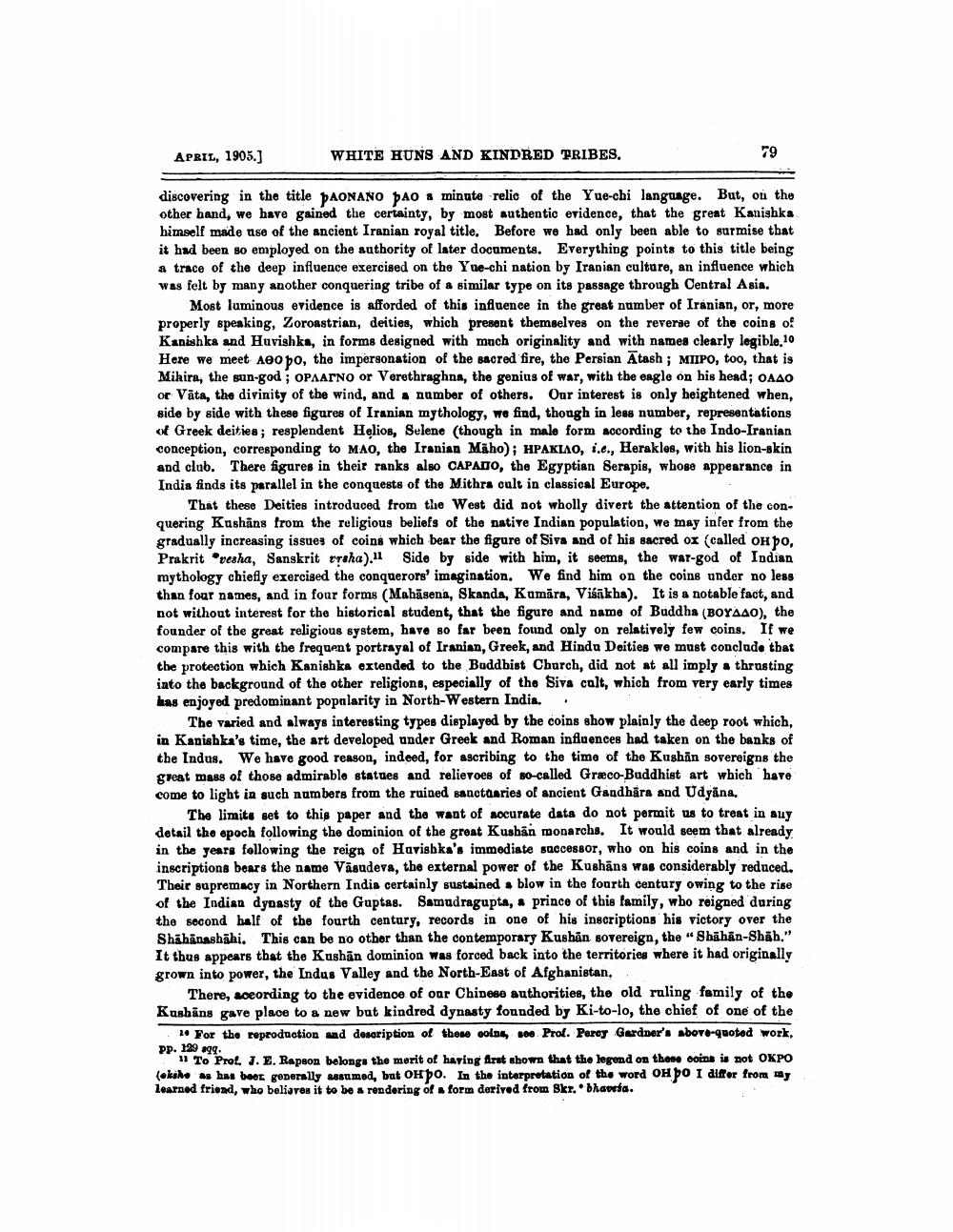________________
APRIL, 1905.]
WHITE HUNS AND KINDRED PRIBES.
discovering in the title PAONANO PAO & minate relic of the Yue-chi language. But, on the other hand, we have gained the certainty, by most authentic evidence, that the great Kanishka himself made use of the ancient Iranian royal title. Before we had only been able to surmise that it had been so employed on the authority of later documents. Everything points to this title being a trace of the deep influence exercised on the Yue-chi nation by Iranian culture, an influence which was felt by many another conquering tribe of a similar type on its passage through Central Asia.
Most luminous evidence is afforded of this influence in the great number of Iranian, or, more properly speaking, Zoroastrian, deities, which present themselves on the reverse of the coins of Kanishka and Huvishka, in forms designed with much originality and with names clearly legible.10 Here we meet Aeo po, the impersonation of the sacred fire, the Persian Atash; MIIPO, too, that is Mihira, the sun-god; OPAATNO or Verethraghna, the genius of war, with the eagle on bis head; OAO or Vāta, the divinity of the wind, and a number of others. Our interest is only heightened when, side by side with these figures of Iranian mythology, we find, though in less number, representations of Greek deities; resplendent Helios, Selene (though in male form according to the Indo-Iranian conception, corresponding to MAO, the Iranian Māho); HPAKLAO, 1.6., Herakles, with his lion-skin and club. There figures in their ranks also CAPADO, the Egyptian Serapis, whose appearance in Indis finds its parallel in the conquests of the Mithra cult in classical Europo.
That these Deities introduced from the West did not wholly divert the attention of the conquering Kushans from the religious beliefs of the native Indian population, we may infer from the gradually increasing issues of coins which bear the figure of Siva and of his sacred ox (called on po, Prakrit *vesha, Sanskrit rraha).11 Side by side with him, it seems, the war-god of Indian mythology chiefly exercised the conquerors' imagination. We find him on the coins under no less than four names, and in four forms (Mahasena, Skanda, Kumāra, Visūkba). It is a notable fact, and not without interest for the historical student, that the figure and name of Buddha (BOYAAO), the founder of the great religious system, have so far been found only on relatively few coins. If we compare this with the frequent portrayal of Iranian, Greek, and Hindu Deities we must conclude that the protection which Kanishka extended to the Buddhist Church, did not at all imply a thrusting into the background of the other religions, especially of the Siva calt, which from very early times has enjoyed predominant popularity in North-Western India.
The varied and always interesting types displayed by the coins show plainly the deep root which, in Kanishka's time, the art developed under Greek and Roman influences had taken on the banks of the Indus. We have good reason, indeed, for ascribing to the time of the Kushän sovereigns the great mass of those admirable statues and relievoes of so-called Græco-Buddhist art which have come to light in such numbers from the ruined sanctuaries of ancient Gandhāra and Udyana.
The limits set to this paper and the want of accurate data do not permit us to treat in any detail the epoch following the dominion of the great Kushän monarchs. It would seem that already in the years following the reign of Havisbka's immediate successor, who on his coins and in the inscriptions bears the name Vasudeva, the external power of the Kushāns was considerably reduced. Their supremacy in Northern India certainly sustainedblow in the fourth century owing to the rise of the Indian dynasty of the Guptas. Samudragupta, * prince of this family, who reigned during the second half of the fourth century, records in one of his inscriptions his victory over the Shähänashāhi. This can be no other than the contemporary Kushan sovereign, the "Sbāhān-Shāh." It thus appears that the Kushān dominion was forced back into the territories where it had originally grown into power, the Indus Valley and the North-East of Afghanistan,
There, aceording to the evidence of our Chinese authorities, the old ruling family of the Kushāns gave place to a new but kindred dynasty founded by Ki-to-lo, the chief of one of the
** For the reproduction and description of these coins, 10. Prof. Peroy Gerdner's above-quoted work,
"To Prot. J. E. Rapson belongs the merit of having first shown that the legend on those coina is not OKPO (okohe ms has been generally assumed, but ou po. In the interpretation of the word OH PO I differ from thy learned friend, who believes it to be a rendering of a form derived from Skr. bhavda.
PP.




